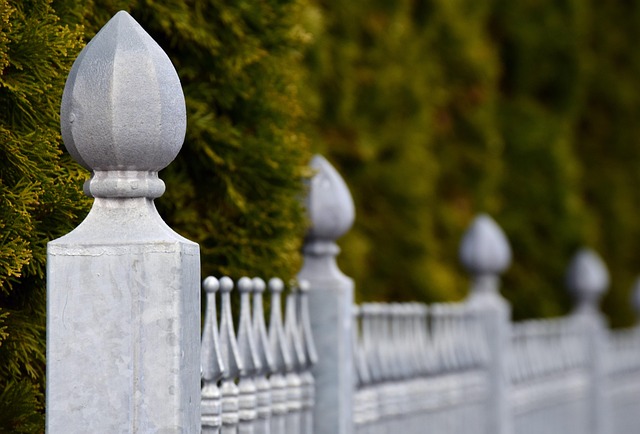New Bedford, MA, is embracing eco-friendly fencing materials, a sustainable solution for homeowners seeking to enhance their properties while contributing to a greener environment. This article explores the diverse options available in the region, highlighting the numerous benefits of organic fencing materials. From reducing environmental impact to promoting local ecosystems and offering low-maintenance solutions, these natural barriers are transforming New Bedford’s landscape. Discover how sustainable fencing practices not only benefit individual properties but also contribute to the overall health of the community and the environment.
- Exploring Eco-Friendly Fencing Options in New Bedford
- Benefits of Sustainable Fencing Materials for Your Property
- Natural Barriers: Organic Fencing Solutions for Local Homes
- How Green Fences Improve New Bedford's Environment
- Longevity and Low Maintenance: Key Advantages of Eco-Fencing
- Community Efforts: Promoting Sustainable Fencing Practices
Exploring Eco-Friendly Fencing Options in New Bedford
New Bedford residents increasingly seek eco-friendly fencing options, aligning with a broader trend toward sustainable living. This shift is driven by both environmental consciousness and aesthetic preferences for natural, low-maintenance solutions. In response, several innovative materials have emerged, offering not only environmental benefits but also enhanced curb appeal. From recycled plastic to organic bamboo and even local wood sources, these options provide diverse choices for property owners looking to reduce their carbon footprint without compromising on style or durability.
Benefits of Sustainable Fencing Materials for Your Property
Adopting eco-friendly fencing materials offers numerous advantages for both your property and the environment in New Bedford, MA. One of the key benefits is reduced carbon footprint; these sustainable options are typically made from recycled or renewable resources, minimizing the environmental impact compared to traditional fence materials. This approach also contributes to local biodiversity by promoting the growth of native plants along the fence line, creating habitats for wildlife.
Sustainable fencing can enhance your property’s aesthetics and value while aligning with contemporary design trends. The natural beauty of these materials, such as wood from sustainably managed forests or bamboo, adds charm and curb appeal. Moreover, unlike synthetic alternatives, organic options are breathable, allowing air circulation and reducing the risk of heat buildup, which benefits both the fence’s longevity and the surrounding landscape.
Natural Barriers: Organic Fencing Solutions for Local Homes
In New Bedford, MA, homeowners looking for eco-friendly fencing options can turn to natural barriers—organic fencing solutions that blend seamlessly with the local landscape. These materials, such as bamboo, wood chips, and composted organic matter, offer not just environmental benefits but also aesthetic appeal. Bamboo, known for its rapid growth and strength, creates durable fences that can withstand various weather conditions. Wood chips, often derived from recycled sources, provide a cost-effective and natural look while preventing soil erosion and promoting healthy plant growth.
Compost-based fencing materials are another sustainable choice. These products are made from organic waste, reducing the environmental footprint further. They not only serve as effective barriers but also act as valuable soil enrichers, fostering healthier gardens. Moreover, these natural solutions can attract beneficial insects and wildlife, contributing to a more biodiverse ecosystem right in one’s backyard.
How Green Fences Improve New Bedford's Environment
In New Bedford, MA, the adoption of green fencing materials is a significant step towards a more sustainable and environmentally friendly urban landscape. These eco-friendly alternatives to traditional fences offer a range of benefits that go beyond aesthetics. By using materials like recycled plastic, wood from sustainable sources, or organic composites, green fences reduce the environmental footprint associated with typical fencing options. They also help mitigate pollution by preventing plastic waste from ending up in landfills or entering water bodies.
Moreover, green fences contribute to the local ecosystem’s health. Planted with native vegetation, they provide habitats for birds and insects, enhancing biodiversity. These living fences can also improve air quality by absorbing pollutants and releasing oxygen, making New Bedford a greener and healthier place to live. Additionally, their natural beauty adds curb appeal, fostering a sense of community pride, and potentially increasing property values, all while promoting environmental consciousness.
Longevity and Low Maintenance: Key Advantages of Eco-Fencing
Eco-friendly fencing materials offer New Bedford residents a unique blend of longevity and low maintenance, making them an attractive option for homeowners seeking sustainable solutions. These modern alternatives to traditional fences are designed to withstand harsh weather conditions while requiring minimal upkeep. Unlike wooden fences that can rot, crack, and necessitate frequent staining or painting, eco-fencing is crafted from durable, natural materials such as recycled plastic, bamboo, or plant fibers. This durability translates into a longer lifespan, reducing the need for frequent replacements.
Moreover, the low-maintenance nature of these fencing options saves residents time and money. With no need for regular cleaning, sealing, or repairs, eco-friendly fences require only occasional hosing down to keep them looking their best. This streamlined approach to maintenance not only simplifies outdoor chores but also contributes to a smaller carbon footprint by reducing the environmental impact associated with manufacturing and disposing of traditional fencing materials.
Community Efforts: Promoting Sustainable Fencing Practices
In New Bedford, MA, community efforts are actively promoting sustainable fencing practices. Local initiatives and educational programs aim to raise awareness among residents about the environmental benefits of eco-friendly fencing materials. These efforts include workshops and seminars that teach homeowners and businesses about the various options available, such as recycled plastic, bamboo, and natural wood treatments. By encouraging the use of these alternative materials, the community is working towards reducing the carbon footprint associated with traditional fencing methods.
Additionally, collaborative projects between local organizations and city authorities have led to the installation of eco-friendly fences in public spaces and community gardens. These visible examples serve as a source of inspiration for residents, demonstrating the practical application and aesthetic appeal of sustainable fencing solutions. Such initiatives not only contribute to a greener environment but also foster a sense of community engagement and collective responsibility towards preserving natural resources.
